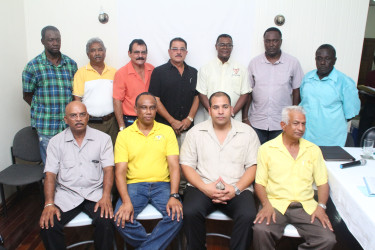In the last 15 months, 28 men have died in mining pit collapses and an inquiry into the problem has cited unsafe practices and the inability of regulatory bodies like the Guyana Geology and Mines Com-mission (GGMC) to take action.
The Commission of Inquiry (CoI) which was constituted by President David Granger after 10 miners died in a collapsed mining pit in May of this year recently submitted its report to the government.

The CoI, which was made up of Commissioners Grantley Walrond, Jo Bayah, Colin Sparman and Gary Hall, determined that many operators practise ‘short cuts’ in the digging of mining pits, which lead to greater instability, especially in the rainy season.
The major findings of the report were revealed yesterday at the annual general meeting of the Guyana Gold and Diamond Miners Association (GGDMA) by Administrative Manager Sparman.
Sparman shared with those gathered that 62 men have lost their lives in the mining sector during the years 2010 to 2015, with 28 deaths occurring in the last fifteen months alone.
He noted that “in most civilised societies this would be considered scandalous and unacceptable, especially considering the low operation base from which this statistic is extracted.”
Aside from neglect, the inquiry has found that worker inexperience, lack of training, lack of technical inputs and corruption at some levels of the regulatory agency contribute to the dangers faced by workers in the sector.
It stressed that a strong “…pressure for gold production at the expense of health and safety exists, thus exposing workers to unacceptable risk and danger.”
Most operators, the report claims, are aware that they are operating in a high hazard environment but do not ensure that the health and safety of their workers are properly managed. It also noted that direct frontline supervision did not adequately assess the health and safety risks that workers were facing.
This resulted in the principal causes of the accidents being neglect of safe mining practices and the absence of controls to make the mining field safe.
In many cases it was found that in steep or high wall pits there was poor ‘benching’ or no benching in some cases. Open-cast mines are dug on benches, which describe vertical levels of the hole very similar to the various levels used in terrace farming to prevent erosions on steep surfaces.
“Many miners live in fear of falling walls, and running from falling walls has become a daily practice,” the report stressed.
The mining sector continues to be characterised by a lack of culture towards occupational safety and health, Sparman contended. “Everyone is wired for gold not for safety,” he said. The report recommended, therefore, that efforts be addressed towards changing this culture through education and sensitisation at all levels.
While most of the report’s recommendations were directed towards strengthening the regulatory ability of the GGMC, owners/operators were also urged to make several changes to the way they function. It was recommended that provisions be put in place to offer comprehensive compensation to family members of miners who may be killed in these accidents.
Presently, operators rarely offer compensation beyond funeral expenses. The CoI recommended that employers provide liability insurance or a compensatory mechanism with clear guidelines for implementation so as to reduce the burden faced by surviving dependents.
Further, the report noted that the available emergency response is inadequate and there is a need for emergency protocols to be put in place.
“We need to train our workers in first response and first aid and other recovery protocols,” Sparman stated. He also noted that there is poor reporting of accidents as the GGMC often learns of these incidents through media reports.





